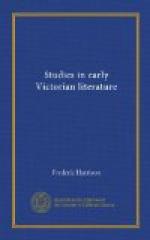This mastery over style—a style at once simple, pure, nervous, flexible, pathetic, and graceful—places Thackeray amongst the very greatest masters of English prose, and undoubtedly as the most certain and faultless of all the prose writers of the Victorian Age. Without saying that he has ever reached quite to the level of some lyrical and apocalyptic descants that we may find in Carlyle and in Ruskin, Thackeray has never fallen into the faults of violence and turgidity which their warmest admirers are bound to confess in many a passage from these our two prose-poets. Carlyle is often grotesque; Macaulay can be pompous; Disraeli, Bulwer, Dickens, are often slovenly and sometimes bombastic; George Eliot is sometimes pedantic, and Ruskin has been stirred into hysterics. But Thackeray’s English, from the first page of his first volume to the last page of his twenty-sixth volume, is natural, scholarly, pure, incisive, and yet gracefully and easily modulated—the language of an English gentleman of culture, wit, knowledge of the world, and consummate ease and self-possession. It is the direct and trenchant language of Swift: but more graceful, more flexible, more courteous.
And what is a truly striking fact about Thackeray’s mastery of style is this—that it was perfectly formed from the beginning; that it hardly ever varied, or developed, or waned in the whole course of his literary career; that his first venture as a very young man is as finished and as ripe as his very latest piece, when he died almost in the act of writing the words—“and his heart throbbed, with an exquisite bliss.” This prodigious precocity in style, such uniform perfection of exact composition, are perhaps without parallel in English literature. At the age of twenty-six Thackeray wrote The History of Samuel Titmarsh and the Great Hoggarty Diamond. It was produced under very melancholy conditions, in the most unfavourable form of publication, and it was mangled by editorial necessities. And yet it can still be read and re-read as one of Thackeray’s masterpieces, trifling and curtailed as it is (for it may be printed in one hundred pages); it is as full of wit, humour, scathing insight, and fine pathos in the midst of burlesque, as is Vanity Fair itself. It is already Thackeray in all his strength, with his “Snobs,” his “Nobs,” his fierce satire, and his exquisite style.
Modern romance has no purer, more pathetic, or simpler page than the tale of the death of poor Samuel Titmarsh’s first child. Though it is, as it deserves to be, a household word, the passage must be quoted here as a specimen of faultless and beautiful style.




